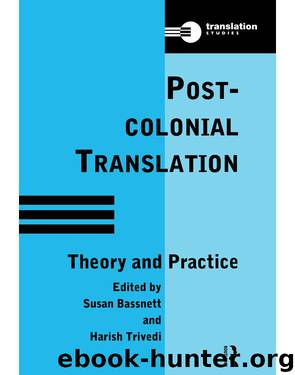Postcolonial Translation by Bassnett Susan; Editor) Susan Bassnett (S; Trivedi Harish

Author:Bassnett, Susan; Editor), Susan Bassnett (S; Trivedi, Harish
Language: eng
Format: epub
Publisher: Taylor and Francis
A parallel development to that of the two generations of Cinema Novo is to be seen in Brazilian popular music. In the mid-1960s, when a CIA and multinational-capital-backed dictatorship was established in Brazil, protest singers like Nara Leão held the view that art should be committed and express a political opinion mostly against authoritarianism. Nara Leão’s ‘mais que nunca é preciso cantar’ (‘more than ever it is necessary to sing’) reveals the tone of mobilization used to elicit an emotional rather than a critical response from the public (Hollanda and Gonçalves 1989: 22–4). Singers also relied heavily on rural music as an expression of a genuine, non-contaminated national culture (Wisnik 1987: 122). Later, Tropicalismo (Tropicalism), a segment of Brazilian popular music associated with Caetano Veloso, among others, moves away from the protest song and from the idea of a non-contaminated national culture, theorizing differently the relationship between Brazil and external influences. Arnaldo Jabor stresses that ‘The importance of Tropicalismo was to say that Brazil is also the calf’s foot-jelly, the general jam, the great multinational confusion that was planted here … Tropicalismo made Brazil aware that reality is more complex than the empire versus the colony’ (Jabor in Hollanda and Gonçalves 1989: 88). Rather than stressing a non-contaminated national culture, Tropicalismo appropriates the cultural forms generated in the international circuit of mass communication. Thus, Brazilian culture emerges as a focus of tensions between the rustic and the industrialized, the acoustic and the electric, the national and the foreign; as such, history emerges as the locus of a complex and unlevelled simultaneity, to use Wisnik’s terms (Wisnik 1987: 122). Tropicalismo, the critic Santiago adds, takes up the anthropophagic move while decentring the geography of Brazilian culture from the land of the palm trees to London, and displacing the Portuguese–Brazilian linguistic axis to a sort of Esperanto – for example, ‘My country has got palm-trees where the Big-Ben chimes’ (Santiago 1978: 124). Still according to Santiago, this linguistic salad, evidence of cosmopolitanism, means that the linguistic sign has no nationality and that in this period of the opening up of cultural frontiers all languages are valid (ibid.: 131–2).
The anthropophagous metaphor continues, then, to contaminate Brazilian critical discourse. Santiago further stresses the political implications of the traditional study of sources and influences in Brazil and Latin America which casts the artist in a position of tributary to the flow of another culture. This conventional critical discourse, Santiago goes on, does not differ in the least from neo-colonialist discourse: both talk of insolvent economies. The sources, he specifically claims, become the unreachable star that, without allowing itself to be contaminated, shines for Latin American artists when they depend on its light for their work. The star illumines the movement of the artists’ hands, but at the same time subjects them to its superior magnetism; critical discourse based on influences sets the star as the only value. To find the ladder to the star and to contract with them the debt which would minimize the
Download
This site does not store any files on its server. We only index and link to content provided by other sites. Please contact the content providers to delete copyright contents if any and email us, we'll remove relevant links or contents immediately.
| Books & Reading | Comparative Literature |
| Criticism & Theory | Genres & Styles |
| Movements & Periods | Reference |
| Regional & Cultural | Women Authors |
4 3 2 1: A Novel by Paul Auster(11775)
The handmaid's tale by Margaret Atwood(7437)
Giovanni's Room by James Baldwin(6795)
Asking the Right Questions: A Guide to Critical Thinking by M. Neil Browne & Stuart M. Keeley(5349)
Big Magic: Creative Living Beyond Fear by Elizabeth Gilbert(5340)
Ego Is the Enemy by Ryan Holiday(4942)
On Writing A Memoir of the Craft by Stephen King(4655)
The Body: A Guide for Occupants by Bill Bryson(4573)
Ken Follett - World without end by Ken Follett(4437)
Bluets by Maggie Nelson(4252)
Adulting by Kelly Williams Brown(4228)
Eat That Frog! by Brian Tracy(4145)
Guilty Pleasures by Laurell K Hamilton(4111)
White Noise - A Novel by Don DeLillo(3825)
The Poetry of Pablo Neruda by Pablo Neruda(3810)
Fingerprints of the Gods by Graham Hancock(3731)
Alive: The Story of the Andes Survivors by Piers Paul Read(3722)
The Book of Joy by Dalai Lama(3683)
The Bookshop by Penelope Fitzgerald(3615)
